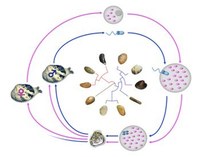
Mitochondria are a fundamental component of the eukaryotic cell. Nonetheless, available data on their heredity and biogenesis are largely incomplete. In animals, the Mitochondrial DNA (mtDNA) is very compact, with few short intergenic regions, but the Control Region, so that one may consider that there is little space for functions other than the usual content related to energy production. This claim, however, is too simplistic, as mtDNA may carry other functions, related to different aspects of eukaryotic cell life.
R. philippinarum, a clam species largely harvested in the Adriatic Sea, it is particularly relevant for the studies of mitochondrial biology, as it shows an unusual mitochondrial inheritance system, which has been observed, so far, in several, but not all, bivalves: The Doubly Uniparental Inheritance (DUI). DUI bivalves have two mitochondrial lineages, one transmitted through eggs (called F), the other through sperm (called M). DUI is the most noteworthy exception to the rule of maternal inheritance of Mitochondria in animals (i.e. matrilinear inheritance). In DUI bivalve species, after fertilization, the embryo shows both F and M mtDNAs, a status that is eventually maintained only in males, although these will only transmit M with spermatozoa. Conversely, in females the M Mitochondria are degraded (or diluted below detection limits), so that they will transmit the F ones only through the eggs.
There is both molecular and phylogenetic evidence that DUI evolved as a modification of maternal inheritance. By its nature, DUI offers a privileged model system to study heredity and biogenesis of Mitochondria and, above all, on the relation between Mitochondria and germ line. Moreover, DUI is very useful to study mitochondrial heteroplasmy and its consequences on bioenergetics of these bivalve species. Finally, it may be helpful to shed light on the evolutionary processes of the eukaryotic genome, on genome conflicts and mito-nuclear coevolution.